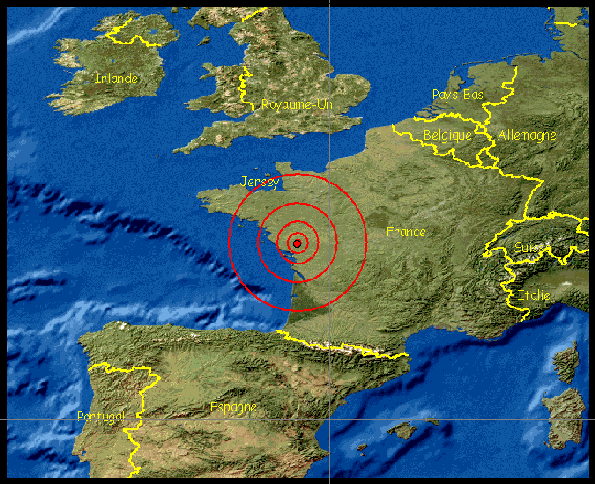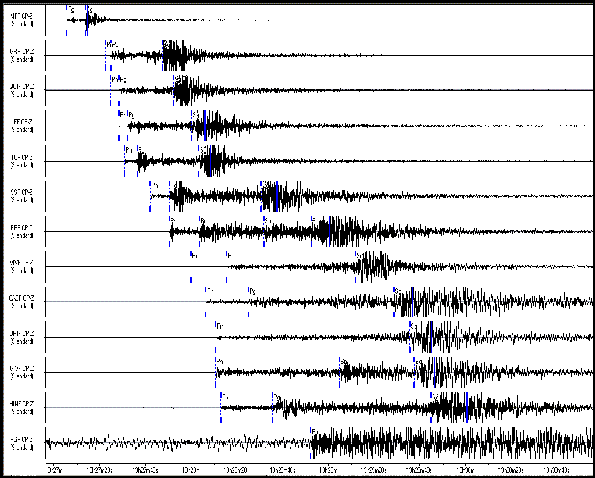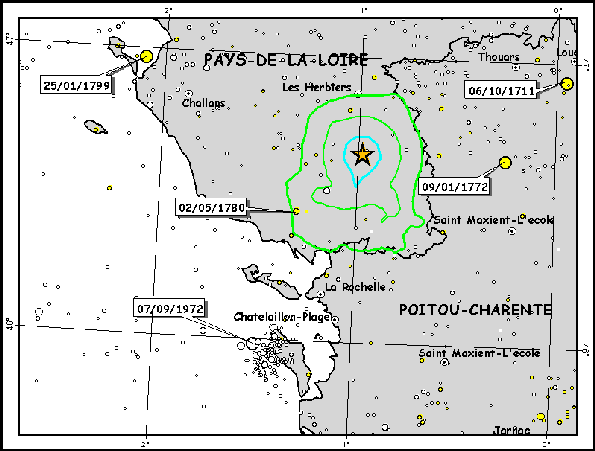 |
 |
 |
 |
 |
 |
 |
 |
 |
 |
Scientific files |
 |
 |
| |

 |
Earthquake in the La Roche-sur-Yon area on June 8, 2001 |
MEMORANDUM FROM THE LABORATORY FOR DETECTION AND GEOPHYSICS (LDG)
On June 8, 2001 at 1:27 pm (UT), an earthquake of magnitude ML 5.1 occurred 25 km east of La Roche-sur-Yon (Vendée, refer to Figure 1). Its focal depth was less than 10 km.

 |
Figure 1: Earthquake location map |
Thanks to the automatic detection and location processing performed immediately after the recording of the signals on the DASE/LDG seismic network (Figure 2), it was possible to quickly answer queries from the French civil security service (which was inundated by calls from local residents as the earthquake had been largely felt as far as La Rochelle, Poitiers and Luçon, etc.).

 |
Figure 2: Signals recorded on the DASE/LDG seismic network |
No damage has been reported to date. This is compatible with the earthquake effects (or macroseismic effects, refer to Figure 3) estimated by the DASE/LDG. The effects are estimated at intensity VI (widely-felt earthquake), which is below intensity VII, the intensity above which local damage can be observed.

 |
Figure 3: Simulation of isoseismal lines (lines of equal intensity) using geological knowledge and event characteristics |
This earthquake occurred in an area situated between the Bay of Biscay and the south of the Armorican Massif. This is an area of significant seismic activity. The main example of this activity is the instrumental earthquake of magnitude 5.7 that occurred on September 7, 1972 about 10 kilometers west of the island of Oléron. The area has a history of other earthquakes. For example, the following earthquakes occurred less than 100 km away from the epicenter of the 2001 earthquake: January 9, 1772 (magnitude: 5.1, maximum intensity: VII-VIII), May 2, 1780 (magnitude: 4.6, maximum intensity: VI-VII) and January 25, 1799 (magnitude: 5.1, maximum intensity: VII-VIII) (Figure 4). This area is dominated by a north-south compression, which is linked to the movement of Africa towards Europe. This compression is reactivating N130-150 directed faults (related to the Armorican Massif) of the right-slip fault (horizontal slip) type.
Seismic activity in the next few days will most likely result in a few earthquakes that could be felt by residents locally. Nevertheless, aftershock magnitude is generally below main shock magnitude. Two aftershocks (magnitude 3.2 and 2.7) have already been recorded at 1:34 pm and 2:32 pm (UT).
|
|
|